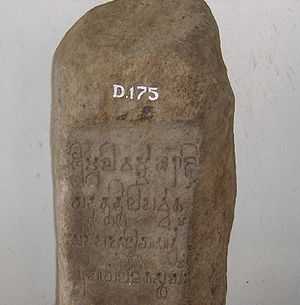Kudungga
Kudungga is the founder of the kingdom of Kutai Martadipura king with the title of Maharaja Kudungga Anumerta Dewawarman, who ruled around the year 350 AD or 4th century AD. At first Kutai Martadipura led by Kudungga yet serves as a king, but as a community leader or chieftain.[1] Kutai Martadipura during the Kudungga not have a system of governance regularly and systematically.[2]
History

The discovery of the most reliable as a source stating that Martadipura Kutai is the oldest kingdom in the archipelago is yupa.[3] Yupa amount found in Muara Kaman is 7 pieces yupa.[3] According to the results of a study conducted by J.G. de Casparis (1949), yupa-yupa in Muara Kaman which allegedly a Kutai Martadipura civilization heritage found successively in 1879 and 1940.[3]
In yupa-yupa, found inscriptions too, which include posts with Pallawa written in Sanskrit. Letters engraved on yupa thought to have come from the end of the 4th century or early 5th century AD All the monument stone was issued at the command of a leader named Maharaja Mulawarman Naladewa.[4] Mulawarman allegedly are Indonesian people because the name of his grandfather, namely Kudungga (there is also a mention kudunga or kundungga) is the original name of the Indonesian.[4] Kudungga is what is believed to be the forerunner of the first leader of the kingdom of Kutai Martadipura, while Mulawarman is the successor Aswawarman (Kudungga child) which brings the kingdom of Kutai Martadipura at the glory.[4]
R.M. Ng. Poerbatjaraka (1952) interpret the circuit Pallawa Sanskrit recorded on yupa about the genealogy of the kings who had ruled in the early days of the kingdom of Kutai Martadipura in translation:[5]
śrīmatah śrī-narendrasya; kuṇḍuṅgasya mahātmanaḥ; putro śvavarmmo vikhyātah; vaṅśakarttā yathāṅśumān; tasya putrā mahātmānaḥ; trayas traya ivāgnayaḥ; teṣān trayāṇām pravaraḥ; tapo-bala-damānvitaḥ; śrī mūlavarmmā rājendro; yaṣṭvā bahusuvarṇnakam; tasya yajñasya yūpo ‘yam; dvijendrais samprakalpitaḥ.
Artinya:
Sang Mahārāja Kundungga, yang amat mulia, mempunyai putra yang mashur, Sang Aśwawarmman namanya, yang seperti Angśuman (dewa Matahari) menumbuhkan keluarga yang sangat mulia. Sang Aśwawarmman mempunyai putra tiga, seperti api (yang suci). Yang terkemuka dari ketiga putra itu ialah Sang Mūlawarmman, raja yang berperadaban baik, kuat, dan kuasa. Sang Mūlawarmman telah mengadakan kenduri (selamatan yang dinamakan) emas-amat-banyak. Untuk peringatan kenduri (selamatan) itulah tugu batu ini didirikan oleh para brahmana.
From inscription of heritage above can be formulated conclusion that the family tree Martadipura Kutai kingdom, is Kudungga as the first king of Kutai. Kudungga has a son named Aswawarman who then pass on the leadership in the kingdom of Kutai. Aswawarman have three childrens. Of the three childrens Aswawarman have, there is a child who is the most prominent, a child name is Mulawarman as crown prince.[5]
Ancestry
The belief that Kudungga is indigenous Indonesian people based on the investigation that Kudungga clearly not a name that smells of India, although the names of his descendants, namely Aswawarman and Mulawarman, containing elements of names of India.[4] In this case. Poesponegoro and Notosusanto (1993) states that there is a name that is similar to Bugis Kudungga mention, namely Kadungga.[4] The resemblance of this name is considered not just a coincidence given in South Sulawesi also found several inscriptions similar to what is found in Kutai.[4]
Poesponegoro and Notosusanto (1993) further concluded that the most likely, both Kudungga who named his son as well as Aswawarman Aswawarman himself had a son named Mulawarman, eager to equate the degree they or their descendants in order to align with the knight that is in India.[4] This possibility based on the fact that that the word "warman" is derived from the Sanskrit word which is usually used to suffix the names of people in southern India.[2] In the Hindu tradition that comes from India, the social system of society is divided into classes, known as levels where the warrior caste or aristocratic kingdom included in a respectable caste.[4]
In this case. Poesponegoro and Notosusanto (1993) states there is a name that is similar to Bugis Kudungga mention, namely Kadungga.[4] The resemblance of this name is considered not just a coincidence given in South Sulawesi also found several inscriptions similar to what is found in Kutai.[4]
Poesponegoro and Notosusanto (1993) further concluded that the most likely, both Kudungga who named his son as well as Aswawarman and Aswawarman himself had a son named Mulawarman, eager to equate the degree they or their descendants in order to align with the knight at India.[4] This possibility based on the fact of the word "warman" is derived from the Sanskrit word which is usually used to suffix the names of people in southern India.[2] In the Hindu tradition that comes from India, the social system of society is divided into classes, known as levels where the warrior caste or aristocratic kingdom included in a respectable caste.[2]
References
- ↑ Pustaka sekolah diakses 13 Maret 2015
- ↑ 2.0 2.1 2.2 2.3 Melayu Online diakses 20 Februari 2015
- ↑ 3.0 3.1 3.2 Vogel, J.Ph., 1974.The Yupa Inscriptions of king Mulawarman from koetei (east borneo).BKI:Berlin
- ↑ 4.0 4.1 4.2 4.3 4.4 4.5 4.6 4.7 4.8 4.9 4.10 Marwati Djoened Poesponegoro & nugroho notosusanto, 1993. Sejarah nasional Indonesia II. Balai pustaka:Jakarta
- ↑ 5.0 5.1 R.M.Ng.Poerbatjaraka, 1952. Riwajat Indonesia I. Jajasan Pembangunan:Jakarta